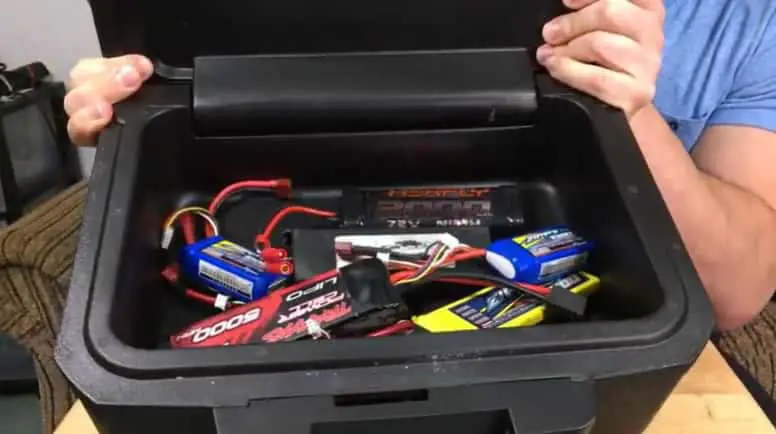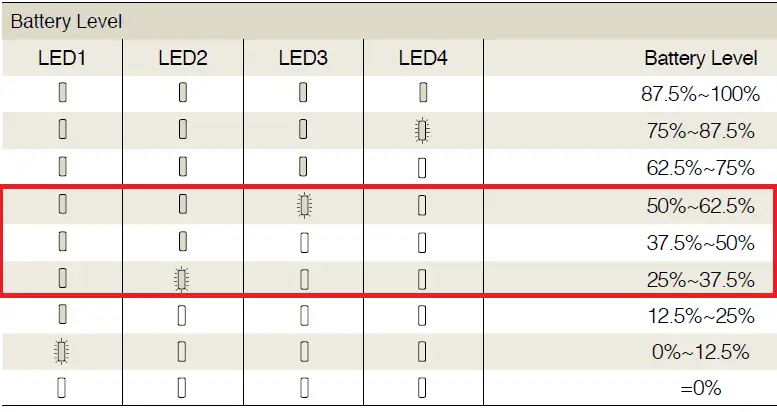
Drone batteries can be extremely expensive and they can cause a lot of damage if not stored properly. By storing your batteries properly, you can extend the battery life, and you can make it safer for everyone around you.
So what’s the best way to store your LiPo drone battery? The best way to store your LiPo drone battery is at the recommended battery charge storage level, which is around 60%. Make sure you store the battery in an easy to reach, safe and dry place that is at room temperature at all times. Never store a drone battery in a hot car, or close to flammable objects.
There are some other very important points that you need to know on how to store your batteries the right way. So keep reading!
If you store your battery the right way, you’ll avoid:
- Damaging your battery. Damage to your battery will obviously shorten the life span of your battery.
- Putting other people at risk in your own home, or while traveling.
Make sure you take the recommended battery storage tips below. It’s in the best interest of yourself and others.
Preparing A LiPo Drone Battery For Storage
Before storing your battery, there are some things you need to do to prepare your battery.
After flying your drone for the last time before storage, make sure you charge your battery back up to the recommended storage level, which is about 60%.
If your battery level is still over 60% after you’ve finished with your last flight, don’t worry. Your battery should be automatically programmed to discharge down to the recommended storage level over a set number of days. DJI defaults to 10 days, however, this can be changed in the GO app.
If you’re planning to store your battery for only a short period, for example, if you’re traveling, then let your LiPo drone battery discharge to around 60% to 80%.
However, if you know your battery is going to be stored for a long period of time, over 10 days to 90 days, then discharge your battery to around 40% to 60%.
A few tips for long term storage:
- Re-check your battery charge levels at least once per month. If it falls below 40% then charge it back up again to avoid damage.
- Avoid storing your batteries unused for more than 3 months. This could cause damage.
NOTE: The above-recommended battery charge storage levels may change depending on the manufacturer of the drone. Always double-check with your manufacturer.
Storing Batteries at Home
If you’re storing your battery at home then the biggest risk here is the safety of your family, and of course your valuables at home. The last thing you want to do is burn down your house. Your wife won’t be too happy!
- Check the battery level monthly. If you’re going to be storing your battery long term, make sure you check your battery level monthly. If your battery level has dropped below 40%, then charge it back up.
- Store them outside. If it’s at all possible, the best place to store your drone batteries out of harm’s way would be to store them outside in your shed or garage. However, this obviously isn’t always possible. But there are other measures you can take to make sure you keep everyone safe.
- Make sure that if the drone battery begins to smoke and burn that it’s easily noticeable. This will give you an early warning so that you can act on it and get the battery out of the house. Imagine if you stored the battery somewhere out of sight, like in an attic. Chances are that by the time you noticed signs of an unstable LiPo drone battery it would be too late.
- Make sure you have a fire extinguisher ready at home. If the battery does catch alight then at least you have the tools to put the fire out quickly. Also, make sure your family is trained up on how to use a fire extinguisher just in case something happens when you are not at home.
- Store your battery in a fireproof charging safe or bag. Most of these bags are designed to contain the flames and stop toxic smoke from filling the house.
- Store your battery in a cool area that’s well ventilated and room temperature. Never store it anywhere hot like a car or a tool shed etc.
- Store your batteries away from highly flammable items such as cleaning items, gasoline cans, gas lines/bottles, and even near a large pile of newspapers. I think this is pretty self-explanatory, but just put some thought into where you store them. If the battery does catch alight you want to be able to control the fire as quickly as possible.
- Store them far away from valuable personal possessions. If something does go wrong you want the damage to be a cheap as possible. This is a very simple way to keep it from becoming costly.
Storing Batteries For Travelling
Storing LiPo batteries for traveling is a bit more tricky and takes a bit more planning. In this section, I’ll assume you’re traveling abroad on an international flight, however, keep in mind that these travel storage tips can be applied to any forms of travel.
While going through the airport your drone and batteries will more than likely be checked by a TSA agent. So make sure they are packed as safety as possible to avoid getting flagged down.
Here are some best ways to pack your batteries:
- Before the flight, make sure your batteries are discharged down to storage levels. Which for most drones would be around 60%.
- According to FAA flight rules, your batteries need to be stored safely to stop them from being damaged which may cause them to burn up. So in short here, please don’t try and travel with your batteries flopping around. Store them neatly in a drone travel case, or if you have a camera bag, you can also store them in the battery sleeve.
- For extra safety, you can also tape up the gold plates to avoid them from short-circuiting.
Some extra tips for traveling with drone batteries through an airport:
- Make sure you print out TSA’s drone battery regulations. There are a lot of TSA agents that don’t know their own laws on drones. So if you have it printed, they can’t argue with you.
- Pack your batteries in a way that makes it quick and easy to remove. You’ll probably have to take them out often to show different agents, so have the ways to access.
- Phone your airline to ask if they have any other drone policies. Just to make sure. Different airlines release new drone laws all the time.
- Never leave the batteries unoccupied.
If you’re planning to travel with your drone on an airplane, I highly recommend you read our article that summarizes things you need to know when traveling with a drone.
Battery Storage Levels for the DJI
If you’re wondering what your drones battery storage level is, have a look at the image below that I pulled from MavicHelp. The red box shows what your batter level should be during storage.

This table is for the DJI however I’ve heard that most LiPo drone batteries need to be stored at similar levels. However, if you want to be on the safe side, make sure you contact your drones manufacturer and ask them.
Battery Storage Accessories
Whether you’re storing batteries to travel abroad, travel your car or even if you’re planning on staying at home, there are always some accessories out there that can make storage a lot safer.
- Charging bags are generally made from flame-resistant material. Generally, these are better for traveling because they are a lot smaller and lighter than the charging safe below. Charging bags are great because they reduce the risk of LIPO fires during traveling. I highly recommend using these especially if you’re going on long flights abroad.
- Charging safes are another option especially if you’re looking to store your drone battery at home. They might be a lot more expensive, around $60, however they could save you thousands of dollars. They are designed to stop toxic smoke and to be fireproof. So even if your battery explodes at home while no one is there, your home and personal belongings will still be protected.
